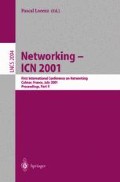abstract
In response to the lack of realistic performance guarantees in “store and forward” networks, the asynchronous transfer mode (ATM) network has resurrected the idea of connection oriented calls. Thus, for every user call, the ATM network first determines and verifies a route, where possible, that meets the user’s quality of service (QoS) requirements, and then transports the traffic along the route. In classic telephony, a typical call processing event Pe requires 200 ms while an average call duration Cd lasts 90 s. The ratio Pe/Cd = 450, is large enough to render the call processing effort meaningful. While the link bandwidth in classic telephony is 64 Kb/s and each user call is allocated an identical 8 Kb/s bandwidth, links bandwidths in ATM equal or exceed 155 Mb/s and users may be allocated, in general, much higher, variable bandwidths depending on need and availability. This paper projects that the trend of short call durations, of ftp, http, image retrieval, and email messages type, will gain increasing processing prominence in the future, fueled by our impatience and the rapid growth in the backbone link bandwidths that is already outpacing the expected increase in the average message size transported across the networks. As backbone speeds increase and call durations decrease, networks will be perceived as more responsive and potentially attract a very high rate of users interacting with the networks. Under these circumstances, it is unlikely for the traditional uniprocessor based ATM node architecture to successfully address the increased call processing demand, resulting in overall performance degradation. Therefore, new call processing architectures for ATM node are necessary. An efficient distributed call processor architecture has been presented in [1] to accelerate the call setup process. Since the architecture is designed to address a highly stressed network, just short of driving it into “instability,” it is imperative that while preserving the quality of service (QoS) guarantees, the distributed call processing architecture prevent perturbations on the network during peek traffic hours. This need translates into the stability of the network in the presence of user call requests and QoS metrics. Network stability is viewed as a condition that must be satisfied so that a large scale decentralized representative high speed network will consistently perform without degradation in the presence of unexpected perturbation. This paper presents the stability study for a representative, large-scale, Private Network Network Interface (PNNI) ATM network under the distributed call processing introduced in [1].
Access this chapter
Tax calculation will be finalised at checkout
Purchases are for personal use only
Preview
Unable to display preview. Download preview PDF.
References
Ricardo Citro, Distributed Call Processing and Reconfigurable Buffer Management Architectures in Asynchronous Transfer Mode Networks, PhD Dissertation, Networking and Distributed Algorithms Lab., Department of Computer Science and Engineering, Arizona State University, May 1999.
Tony Lee and Sumit Ghosh, A Distributed Approach to Real-Time Payements-Processing in a Partially-Connected Network of Banks, Journal of the Society for Computer Simulation, San Diego, CA 92177, Vol. 62(No.3):180–201, March 1994.
Sumit Ghosh and Tony Lee, Modeling and Asynchronous Distributed Simulation: Analyzing Complex Systems. IEEE Press, June 2000
Tony Lee and Sumit Ghosh. On “Stability” in Asynchronous, Distributed, Decision-making Systems. IEE Transactions on Systems, Man, and Cybernetics, 30, Part B(4):549–561, August 2000.
Chengzhi Li, Raba, A and Wei Zhao, Stability in ATM Networks, Proceedings of IEEE INFOCOM’ 97, Vol. 1:160–167, 1997.
“MCI Systems Technical Documentation”. (www.mci.com URL ), 1998.
“ATM Foruim Technical Committee. Private Network-Network Interface Specification Version 1.0 (PNNI 1.0). Internet version af-pnni-0055.000”, (available online: http://www.atmforum/atmforum/specs/approved.html (March)), 1996.
Author information
Authors and Affiliations
Rights and permissions
Copyright information
© 2001 Springer-Verlag Berlin Heidelberg
About this paper
Cite this paper
Citro, R., Ghosh, S. (2001). Simulation–Based Stability of a Representative, Large–Scale ATM Network for a Distributed Call Processing Architecture. In: Networking — ICN 2001. ICN 2001. Lecture Notes in Computer Science, vol 2094. Springer, Berlin, Heidelberg. https://doi.org/10.1007/3-540-47734-9_53
Download citation
DOI: https://doi.org/10.1007/3-540-47734-9_53
Publisher Name: Springer, Berlin, Heidelberg
Print ISBN: 978-3-540-42303-4
Online ISBN: 978-3-540-47734-1
eBook Packages: Springer Book Archive

